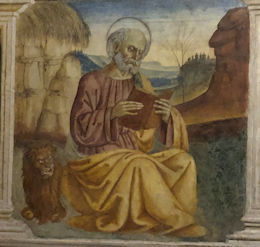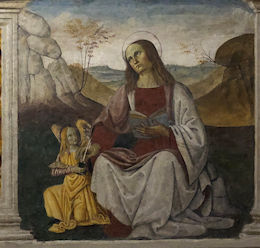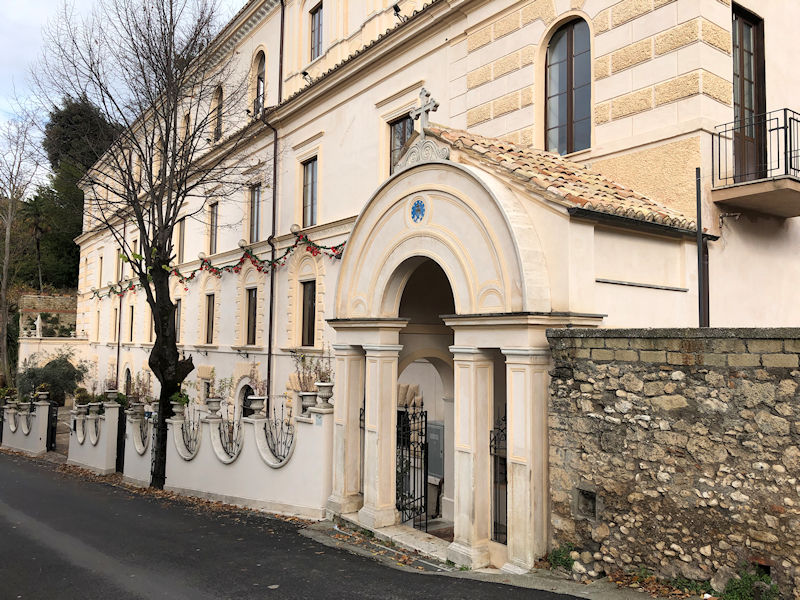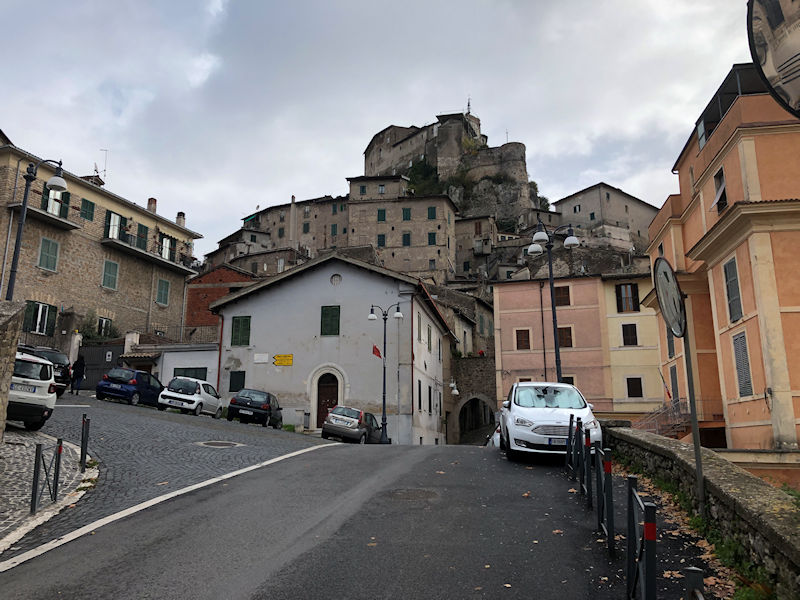You may not find this terribly rewarding unless you're included here, so this is a good time for casual and random browsers to turn back before they get too caught up in the sweep and majesty of the proceedings and can't let go.
We're not based in Europe anymore, and we've struggled through the covid-19 lockdowns like everyone else, so we haven't set foot in Italy since February 2019. Now we're making up for lost time with mad sightseeing, but in a few days we'll be grandly reuniting with Melvin and Choupette again, O Frabjous Day.
Ascoli Piceno was grand fun, but now we've hauled out the Mitsubishi battle-tank and are heading back on the A24 towards Rome, 25 November 2022.
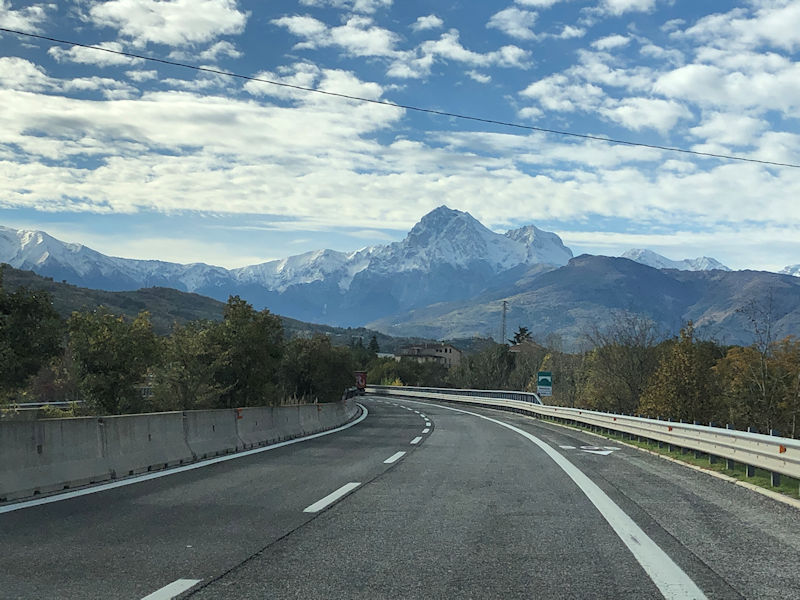
The Gran Sasso d'Italia ('Great Rock of Italy'). We're entering the Gran Sasso e Monti della Laga National Park, along the spine of the Apennine range, and that's the highest peak of the Apennines, the Corno Grande at 2,912m (9,553 ft).

There's a glacier on the Corno Grande, but according to Wikipedia it's expected to be climate-changed away entirely by 2020, which would have been a while ago.
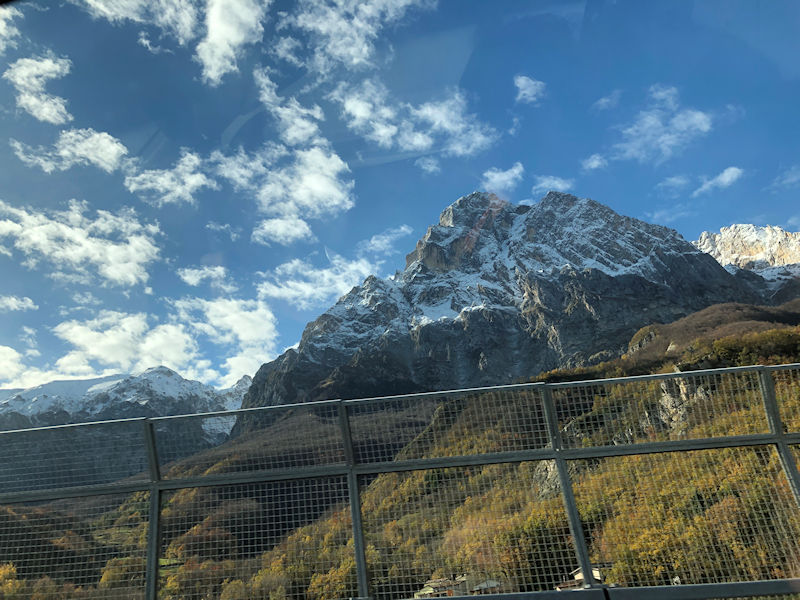
Crossing over that range would be a daunting experience, but . . .

. . . since 1984 we've had this fine 10km tunnel under it.
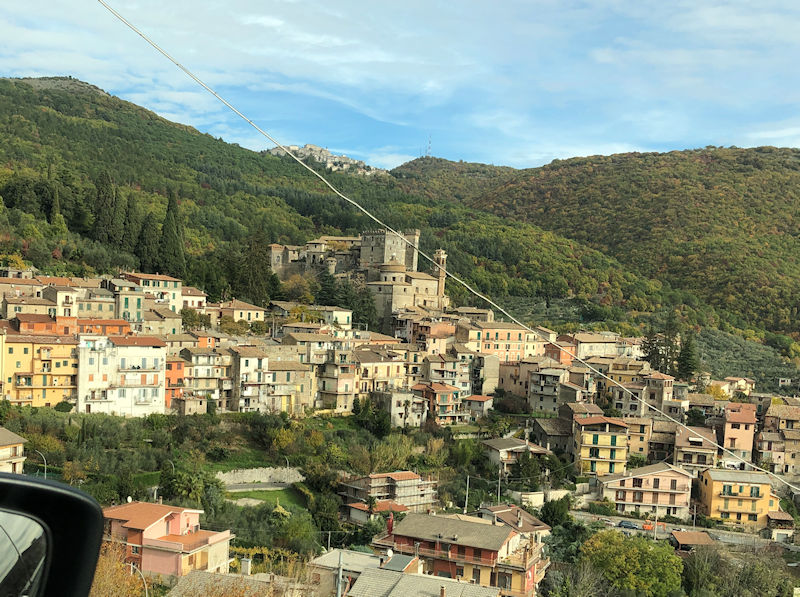
Past the highest peaks but still in mountainy territory, we're passing the cute little village of Arsoli, with its Castello Massimo, built for the Benedictines in the 11th century but purchased by a Fabrizio Massimo in 1574. This place is said to have been a source for an aqueduct to downtown Rome since 600 BC, but presently it seems that the town does not welcome tourism. Wikipedia says: 'The place is currently in a state of decline since there is absolutely nothing to do and the castle is not being renovated'. Sounds a bit harsh.
Note that there's another village up on the horizon.
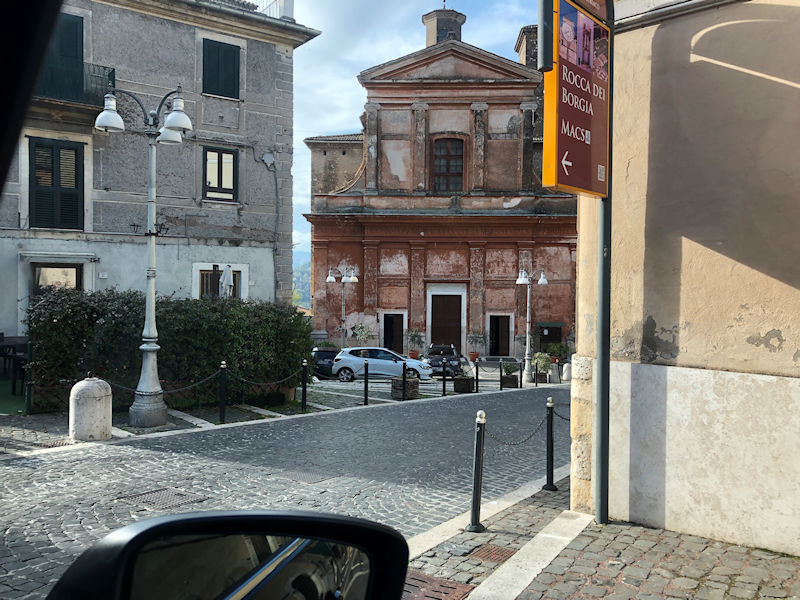
Monsieur Le GPS has led us a merry chase the wrong way into Subiaco (assuming that there's any right way), but we've maneuvered the battle-tank down multiple alleys to more or less where we're meant to end up.
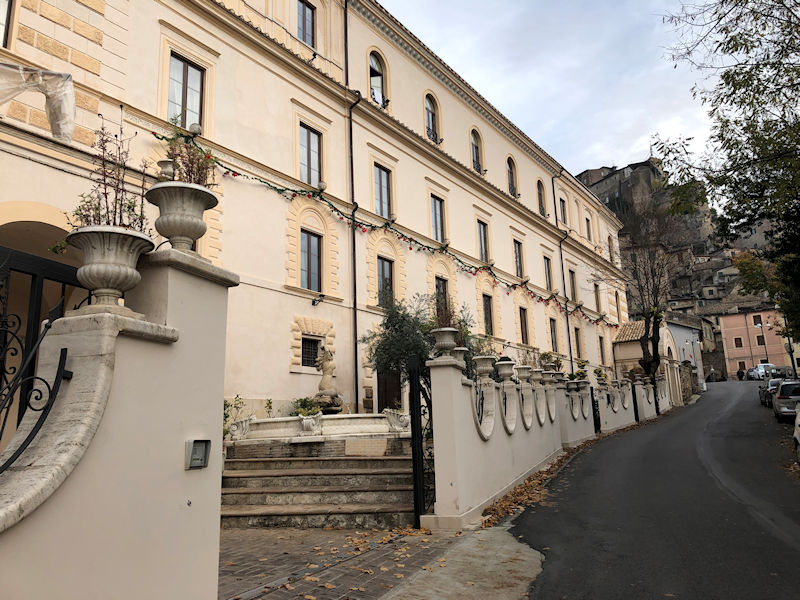
This is it, the Palazzo Moraschi, very big; we're half an hour late and our host has gone off for lunch, but in due time he appeared and helped to wriggle the battle-tank into a small carpark at the far end of the building.
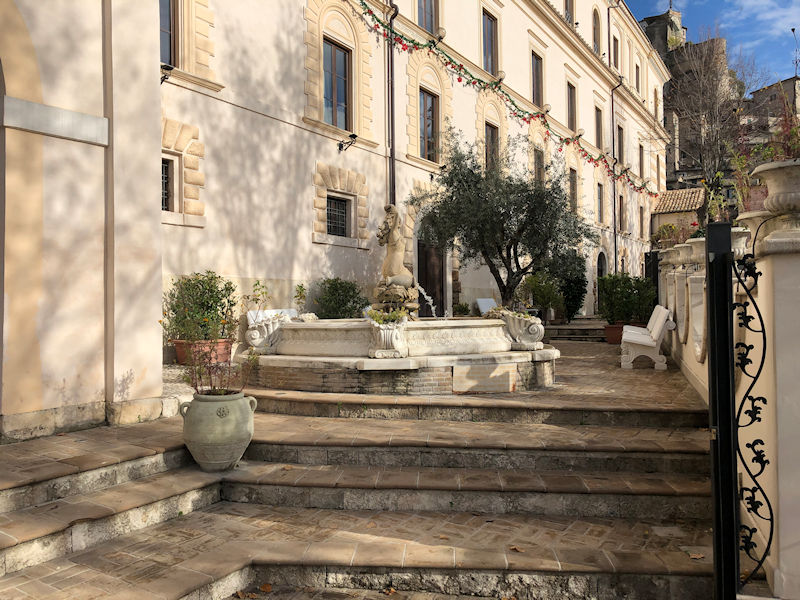
Our host was actually a very welcoming fellow, and the accommodations are extremely good and reasonably priced.
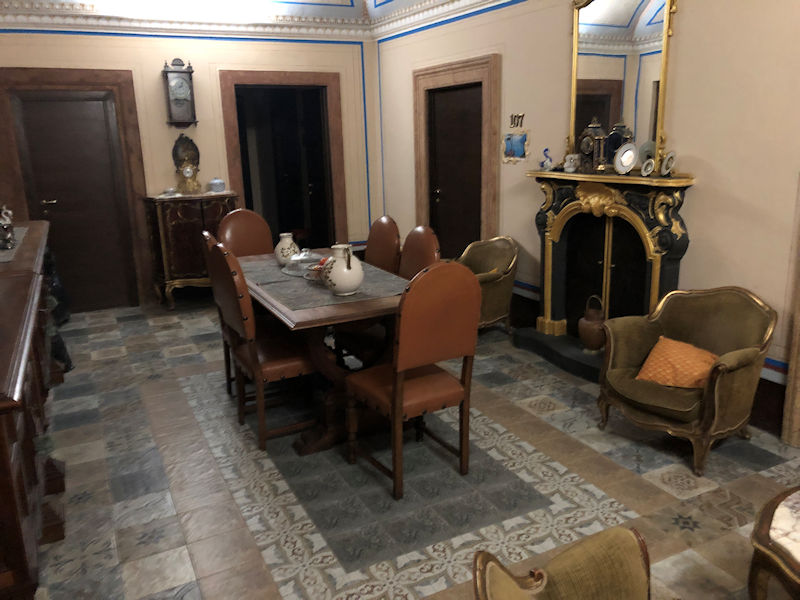
One of the common rooms. We're only here for the one night and, if we're going to get to the frescoes paradise of the Sacro Speco, in St Benedict's Cave, we need to wolf down some lunch and get mobilized.
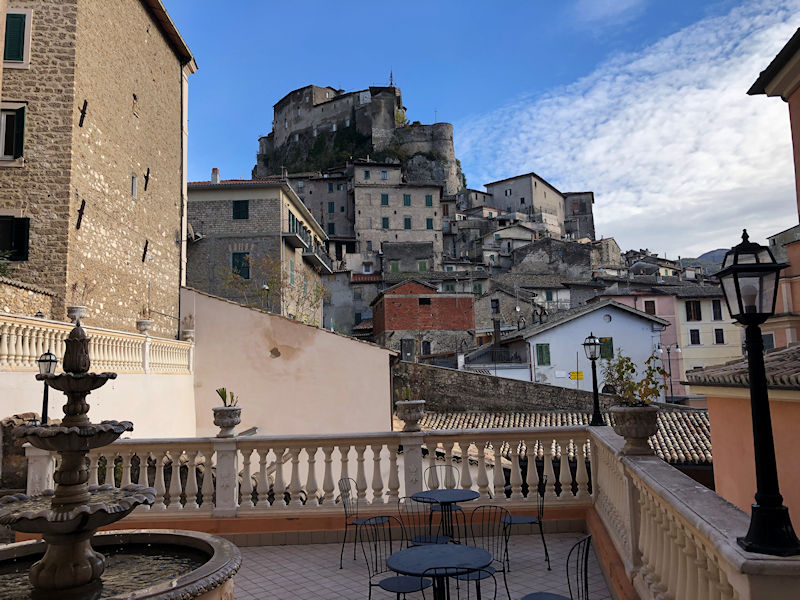
This is a patio out the back of the Palazzo Moraschi, with the variously named Rocca dei Borgia or Rocca Abbaziale. ('Rocca', lit. rock, is just a very common name for an old fortress or stronghold.)
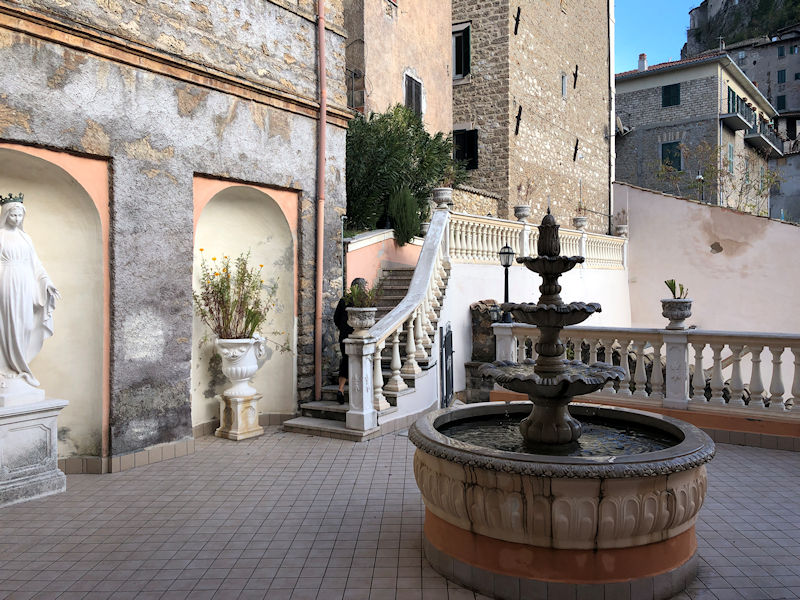
From the back patio to the street above. The present Subiaco is a fairly vertiginous commune in a mountainous region of Lazio, by the river Aniene, with about 8,500 citizens known as the Sublacensei. It has a long and checkered history, but has long been a favorite place of religious pilgrimage, with its Benedictine associations and its Abbey of St Scholastica (named for St Benedict's sister), and in the 20th century, with national investments in infrastructure (like electricity and a proper road), it's become a popular tourist destination as well. It's also included within the protected Regional Natural Park of Monti Simbruini.
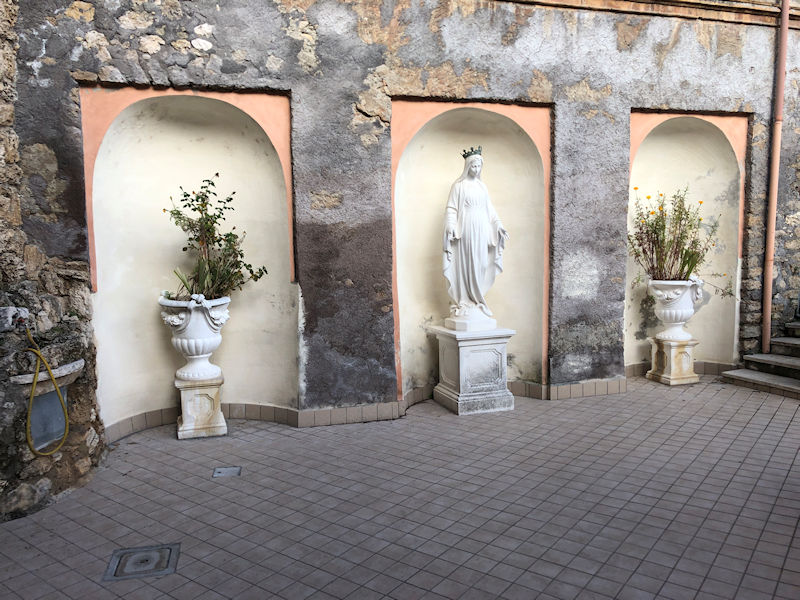
Every patio should have one of these; all we ever get is flamingoes, angels/cherubs, cute fairies, and in the old days, miniature black servants holding up lanterns. There are very few big palaces of the nobility here in Subiaco because, we're told, the abbots, who held feudal rights over the town and surrounding areas, treated the inhabitants as serfs, and never even built a large church in the town.
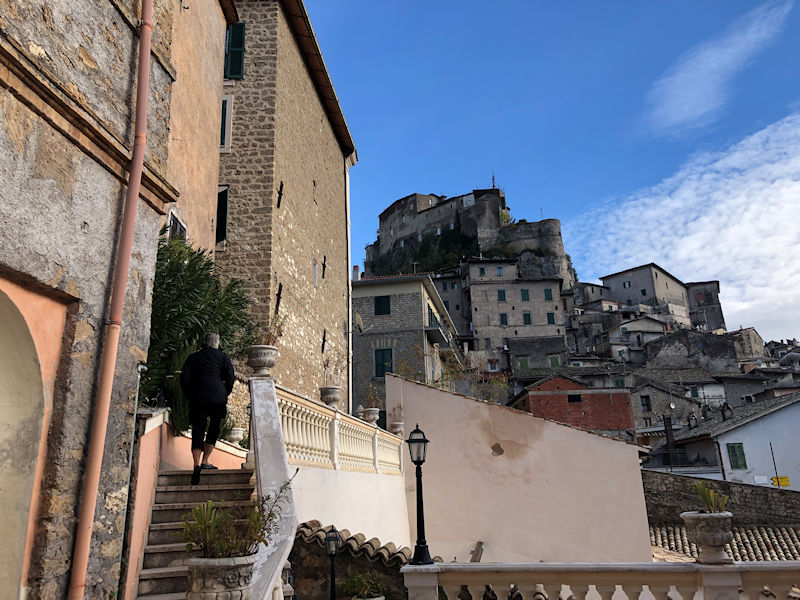
There's a story to the Rocca Abbaziale (the 'Abbot's Castle'), of course. The Benedictine Abbey here built it in the late 11th century to maintain control over their town. It was damaged in an earthquake in 1349 and abandoned; in 1476, however, Cardinal Rodrigo Borgia (the future Pope Alexander VI) restored the fortifications and made it a more comfortable residence, and used to relax here with his mistress Vannozza dei Cattanei. It was here, in fact, that both Cesare Borgia and his sister Lucrezia Borgia were born, in c.1476 and 1480 [Sarah Bradford, Lucrezia Borgia (2005), p. 15]. After the pope's death in 1503 and the failure of Cesare's attempt to carve out a kingdom of his own in Italy, the pope's perennial enemies from the Colonna family were able to move in. After another upgrade in 1778, later popes were able to use it to take a break from Rome from time to time.
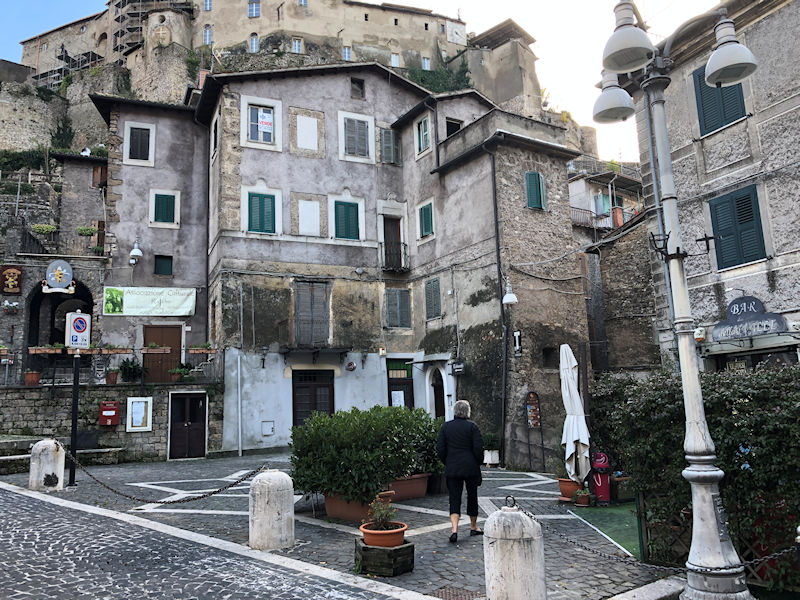
Our leader is seeking out a suitable spot for lunch . . .
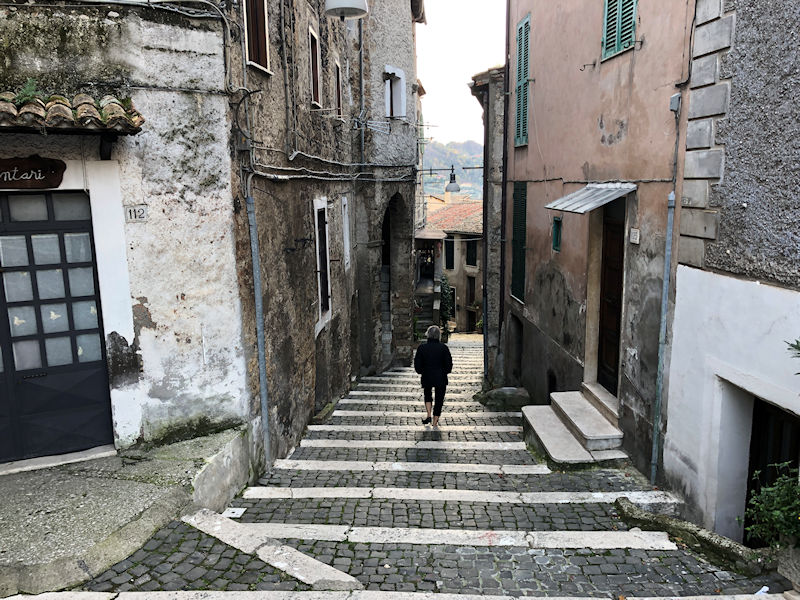
. . . which may require a little serious kneework.

The Italic tribe of the Aequi were conquered by the Romans in 304 BC, and supposedly the name of Subiaco derives from the lakes that Nero had made for his villa here: sublaqueum = 'under the lake'. (The lakes and their dams are all gone now.)
The town was abandoned after the fall of the Empire, and Benedict of Nursia, aged 14 in about AD 494, went off to live in a cave near here and plan his Benedictine Order of monasteries, twelve of which he founded, beginning with the one he sited here at his grotto and including in ca.530 the famous one at Monte Cassino.
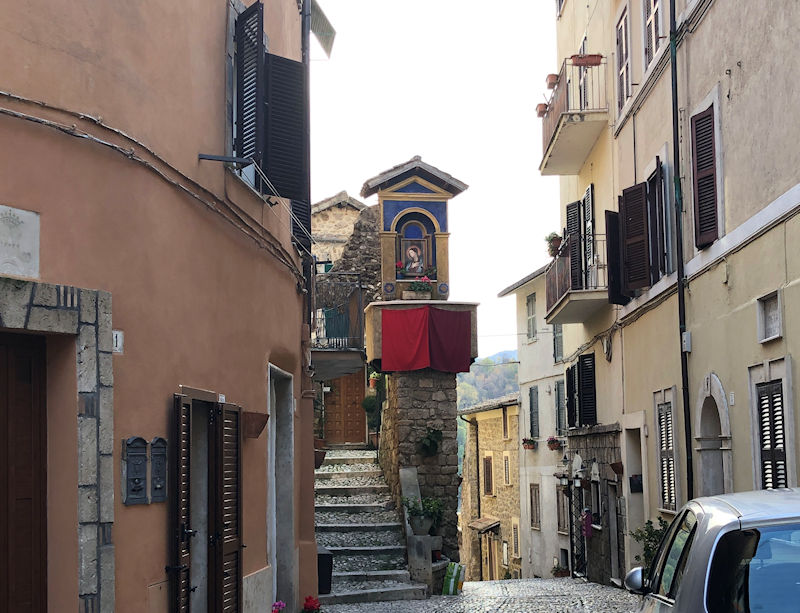
Pretty little stairway ornaments on the way down (that's called the 'Madonna di Pietra Sprecata')
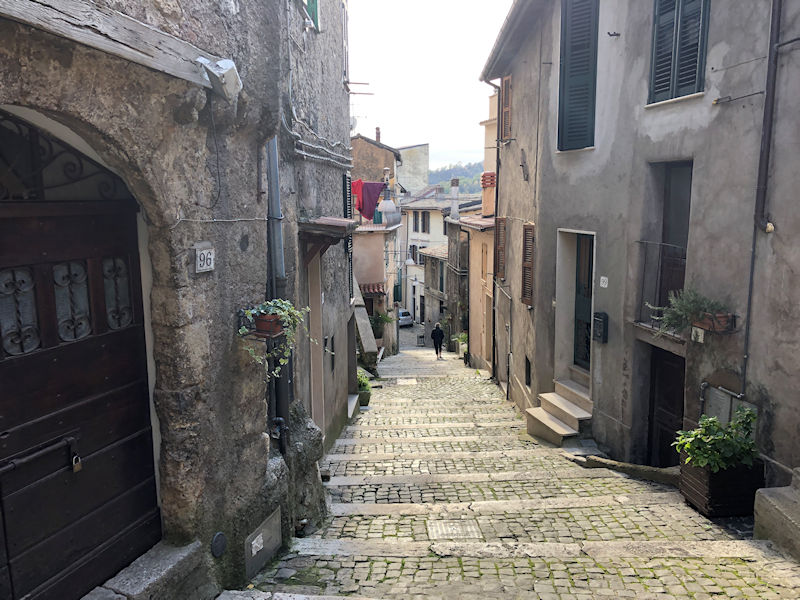
-- Not long now. Wait up.
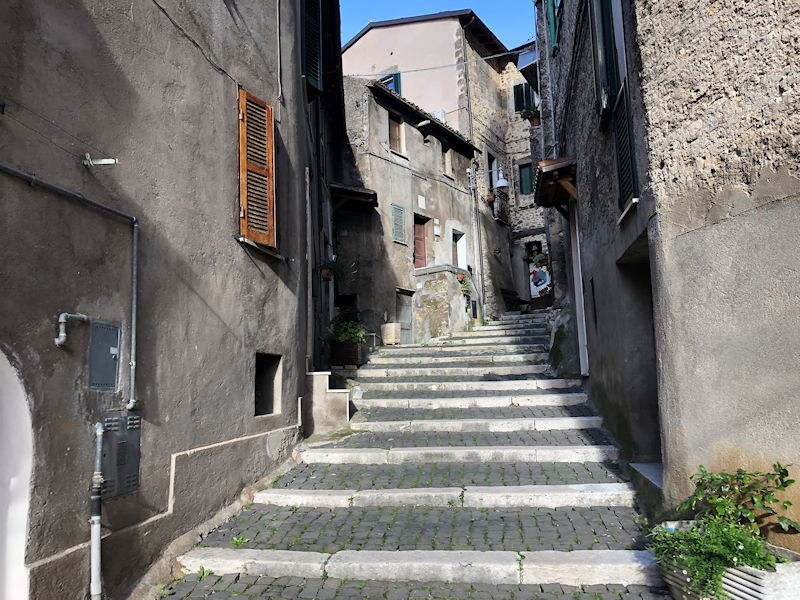
St Benedict's establishment, just a few kilometres up the road from present downtown Subiaco, was destroyed by the Lombards in 601 and abandoned, but then rebuilt under the Byzantine pope John VII, in office 705-707. It was then twice sacked by Saracen raids in the 820s and 870s and again by the Hungarian Magyars, apparently in 981, but was always rebuilt at some point.
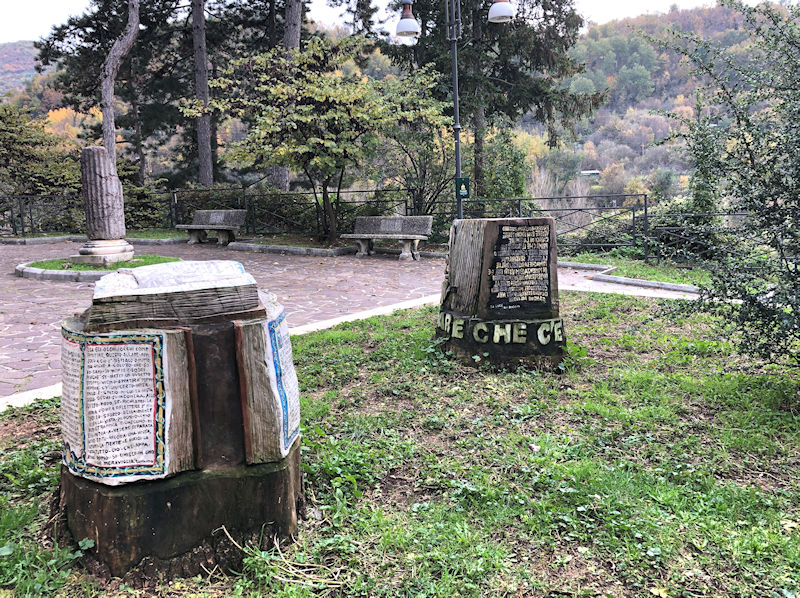
After a quick lunch at the Pinsa Romana 'La Fraschetta', on the Viale della Repubblica, we've descended inexorably through the lower town, and here we're passing the 'Giardino della Stampa', a small park with several ancient-book lawn ornaments, like these, memorializing the two gentlemen, Conrad Sweynheym and Arnold Pannarta, who in 1465 printed the first moveable-type books in Italy here. Their works, all religious, were ordered up by the first Cardinal-Abbot here, Juan de Torquemada (1388-1468), the uncle of Tomás, the famous Grand Inquisitor in Spain.
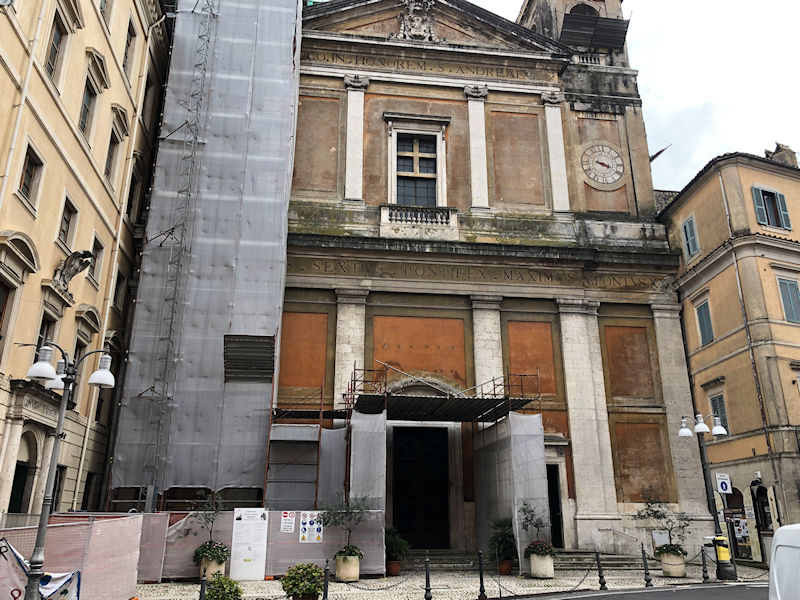
That's the Basilica di Sant'Andrea Apostolo, of the Apostle St Andrew, dedicated in 1789 but nearly destroyed in World War II when Subiaco was heavily bombed by US planes in May-June 1944, and rebuilt and restored in the early 1950s.
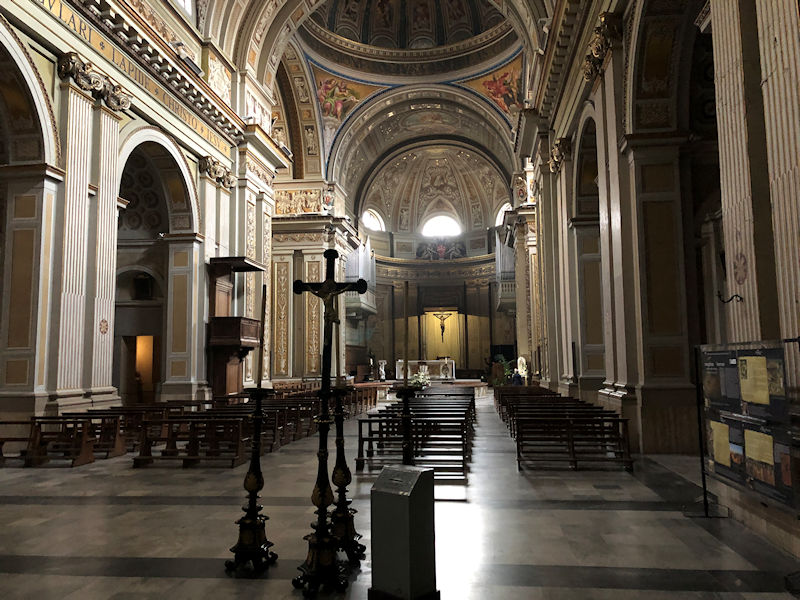
Latin cross with nave & two aisles, simple, clean, dignified

Nice ceiling
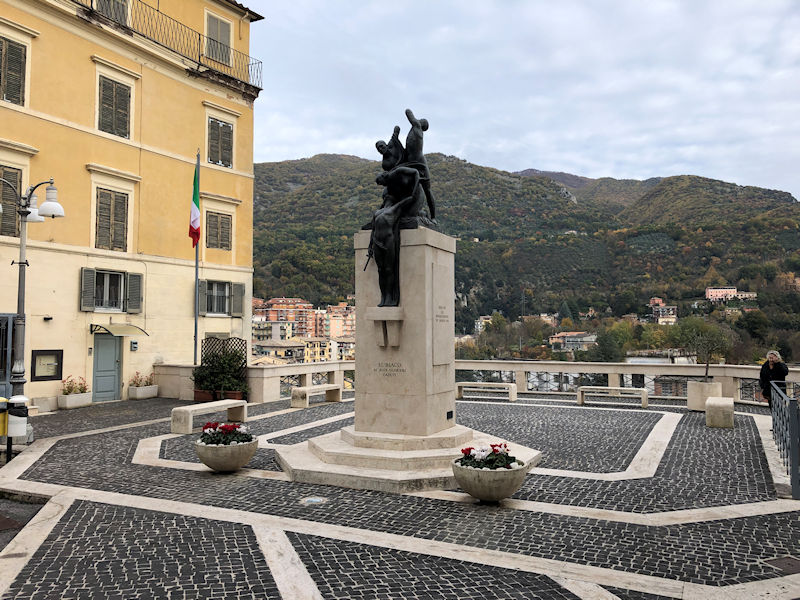
Just outside the St Andrews' Church, in a small piazza with good scenic views, this is the Monument to the Fallen (very strange manly postures, almost a Mussolini look).
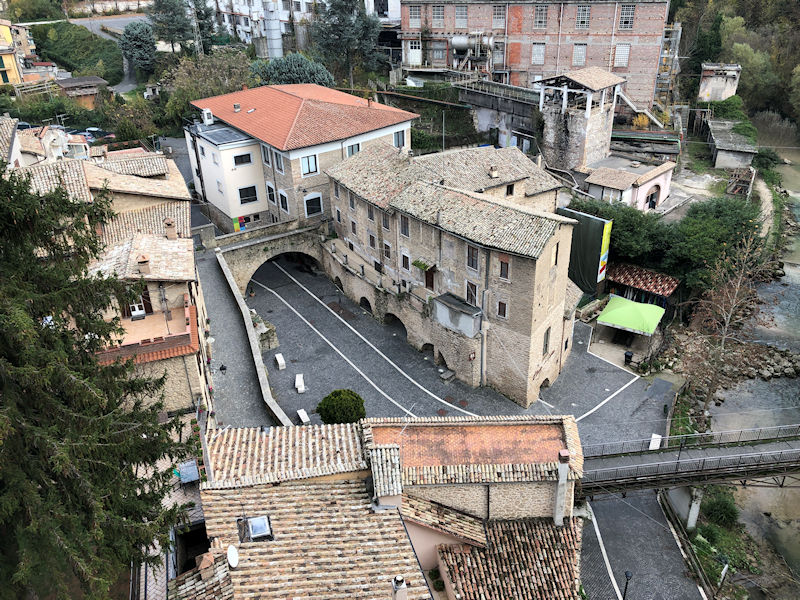
A view from the Monument's piazza down to the lower village beside the River Aniene
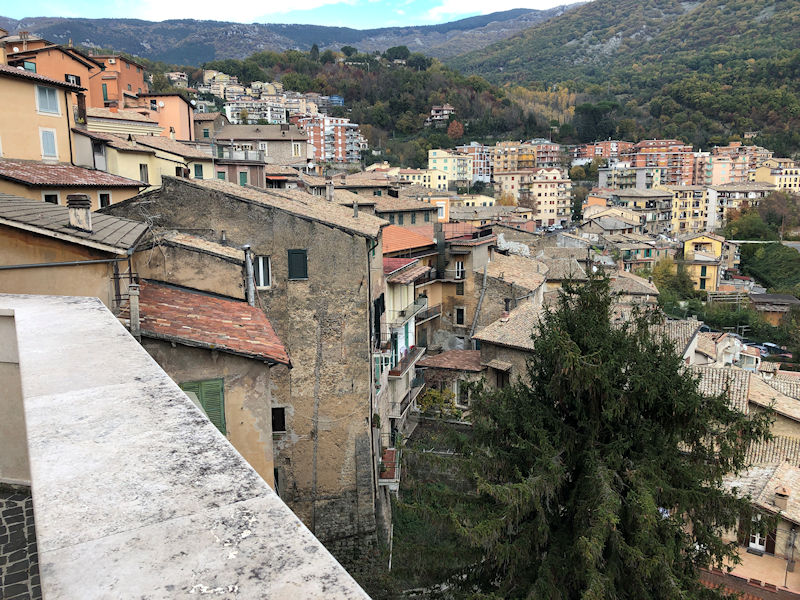
A view of the northern end of the town
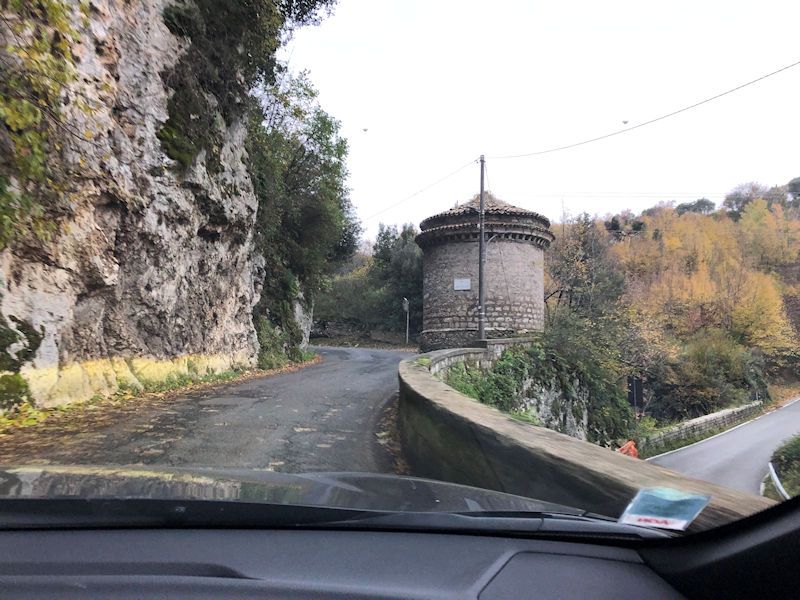
On the small SR411 road about two miles southeast of town, the approach to the monastery starts up a winding road past this Capella or Rotunda di San Mauro (St Maurus was one of Benedict's first disciples). Just round the first bend we passed a nondescript pile of ruins without even a casual glance; we later learnt that it was the remains of Nero's villa.

We've just gone past the complex of the Abbey of Saint Scholastica, or Subiaco Abbey, shown here. That's a secondary target for us, this late in the day, as we're bent upon seeing the frescoes of the Sacro Speco, but at the moment we're ignorant of what lies ahead. So we're leaving the battle-tank here and starting up the trail on foot.

As it turned out, walking up the path paid off with the views. That's the Santa Scolastica abbey below, with its three cloisters, the 10th century church, and the 11th century belltower, and that's the village of Subiaco in the distance.
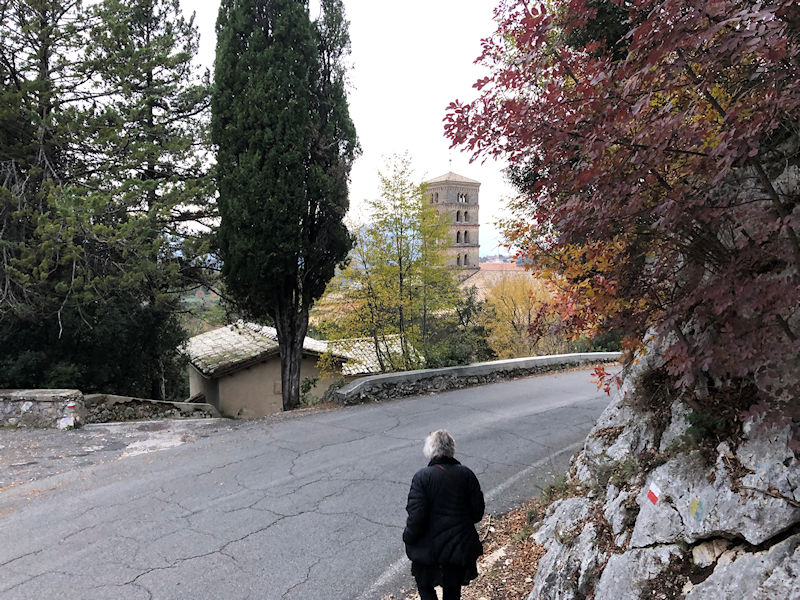
One of a few little sanctuaries along the path, and the belltower looming. St Benedict, by the way, was canonized in 1220 and, even better, declared the 'Patron Saint of Europe' by Pope Paul VI in 1964.
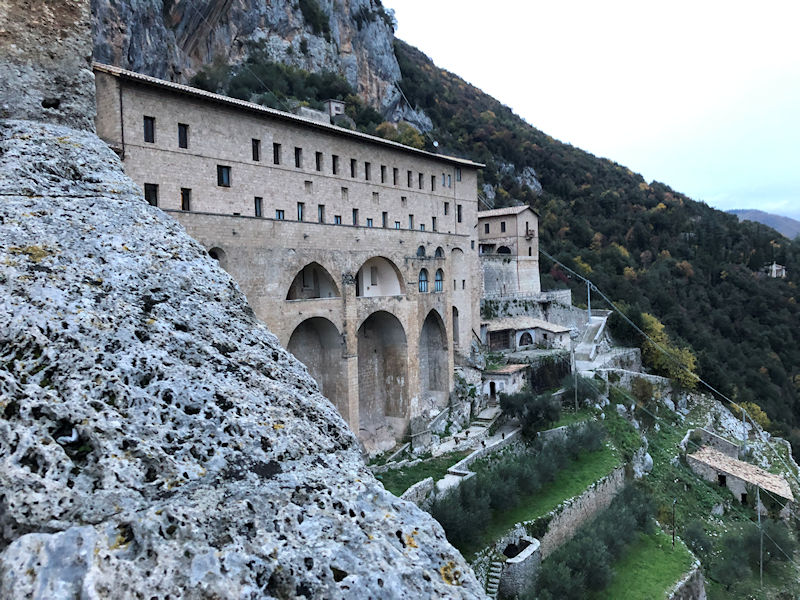
A first view of the Sacro Speco or Holy Cave, aka St Benedict's Cave, or the Monastero di San Benedetto - Sacro Speco
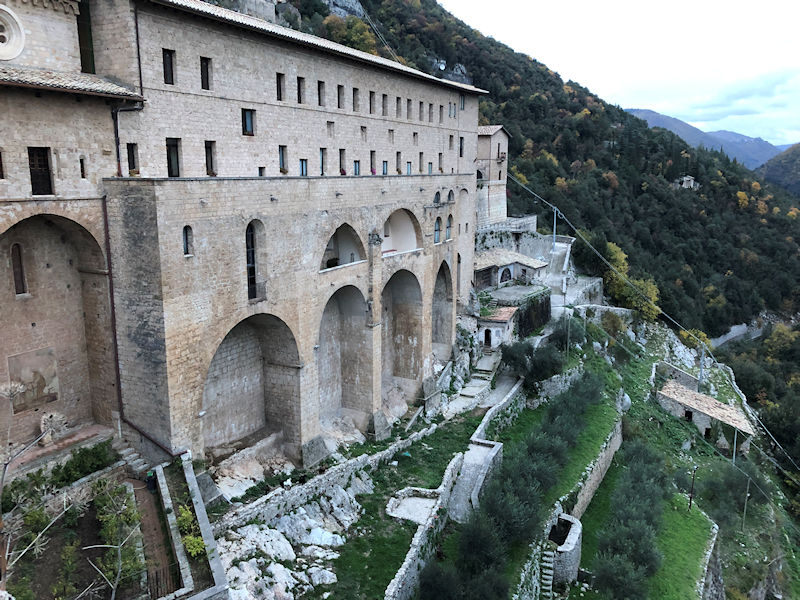
The rose garden is stretched out below what was Benedict's cave hideaway -- there were only thorn bushes there until St Francis visited in 1223 and turned them into roses. The earliest part of the 11th century building is the lower part, including a series of chapels at different levels. This part encloses the hermit Benedict's first grotto and the 'Shepherd's Cave' where he is said to have begun his career by preaching to enthusastic local shepherds who'd heard about him.

Above the lower portion with its chapels and its Chiesa Inferiore, there is the passage leading to the Old Capitular Hall and the Upper Church. The building chronology works from the bottom up. There's also the monastery built in there somewhere, unobtrusively.
In the Old Capitular Hall approaching the Upper Church, here are three of the four evangelists (the fourth one came out blurry), from the 15th century or early 16th century ('School of Perugino'). Generally, the artistic traditions go in reverse chronological order downwards: the Upper Church is basically late 14th century in a Sienese style; the Lower Church is from the second half of the 13th century, and St Gregory's Chapel was done by artists of Byzantine origin. At the bottom, the remains of works from the 9th century can be found in the Shepherd's Cave.
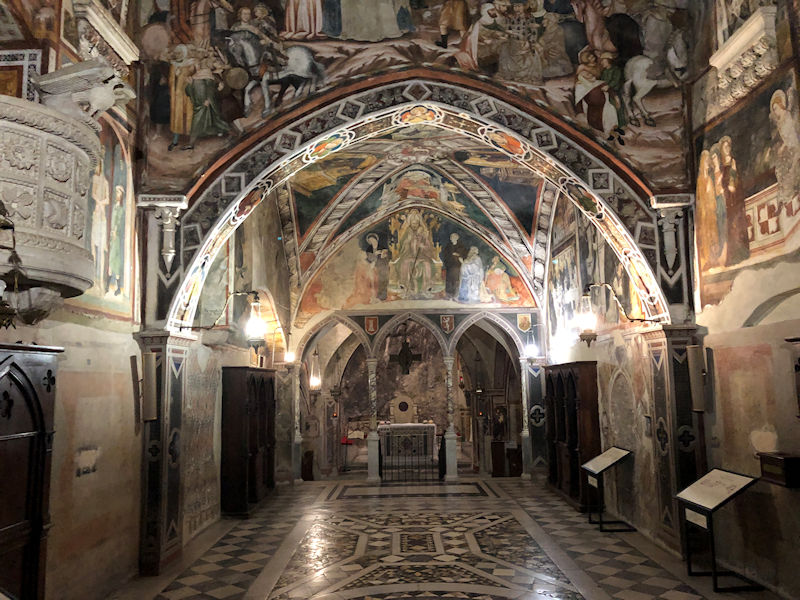
The Upper Church has a single nave, with heaven knows what that's about on the far lunette, but on the archway just above . . .

. . . there's a notable Crucifixion crowd scene, with, oddly, a group of soldiers drawing lots just below the cross to the right who are dressed as 14th century Turks and Arabs.

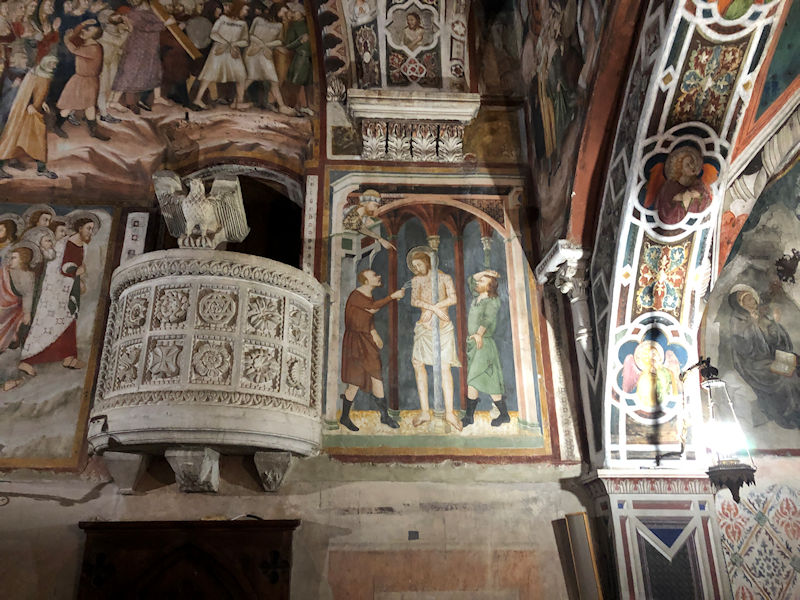
The pulpit, and the Flagellation
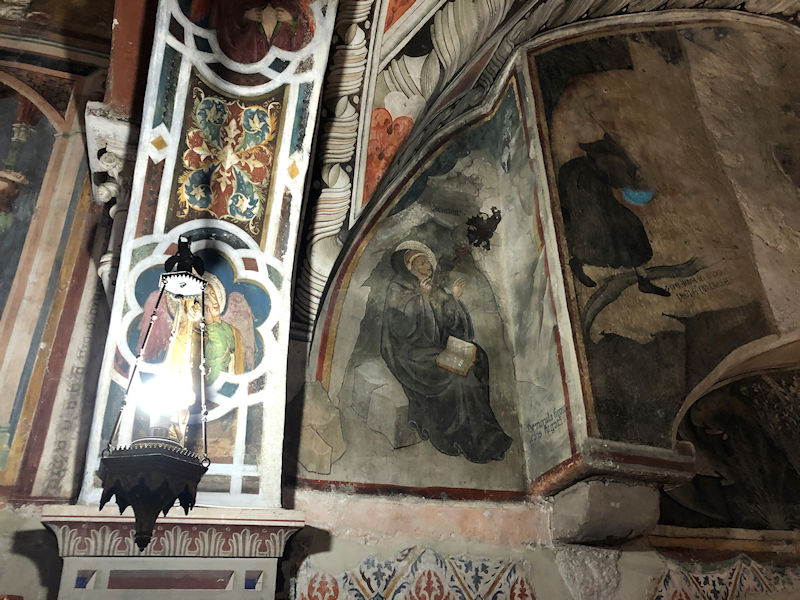
There well may be ninety million frescoes in here, and it would take months to figure out what each of them was meant to be about, and we've only got about an hour. That one, however, certainly shows a demon flying out of somebody.
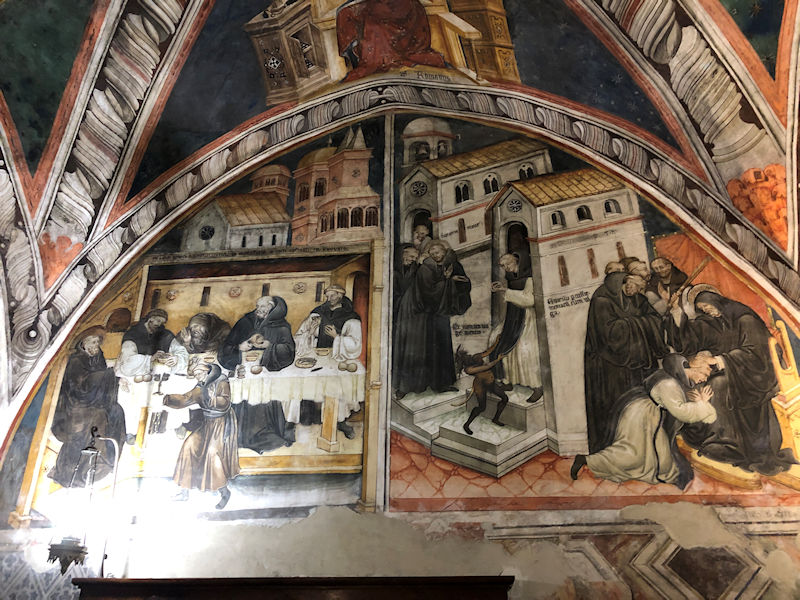
And we've got another demon harassing somebody here. The identifying labels are too small to be read from floor level.

Leaving the Chiesa Superiore and heading downstairs
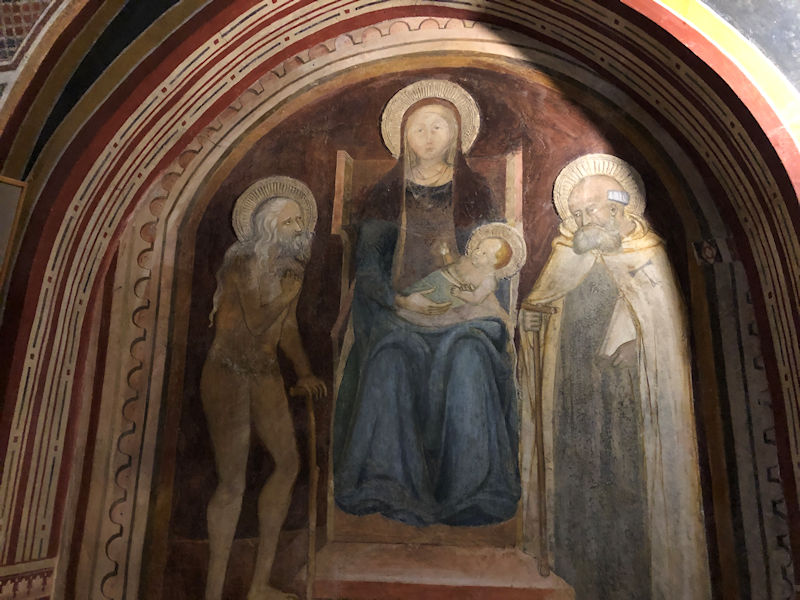
A lugubrious tableau (ominous)
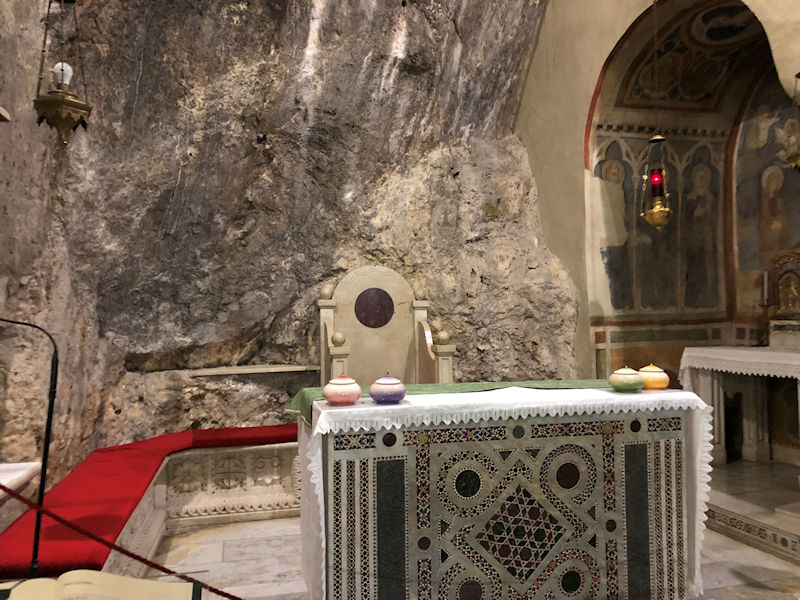
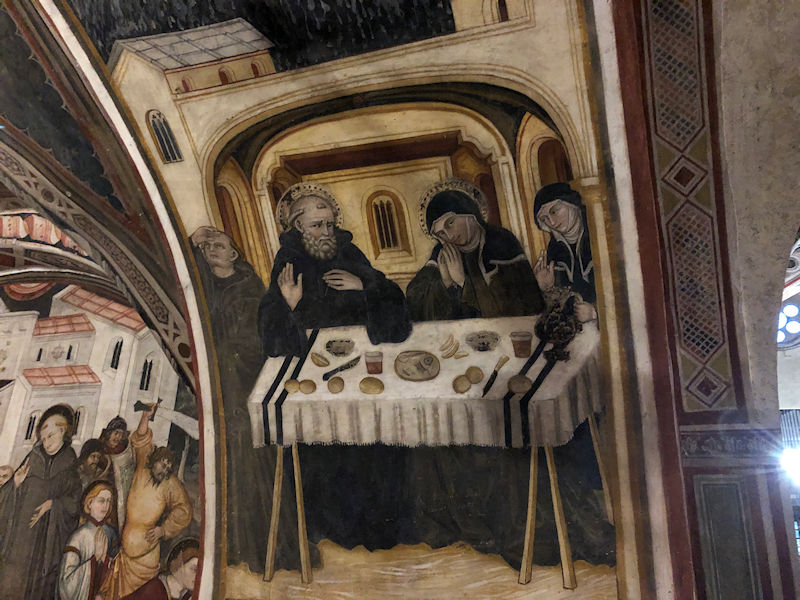
Some Giotto-looking faces (this must be from the Marche/Umbria phase of the artistic contributions)
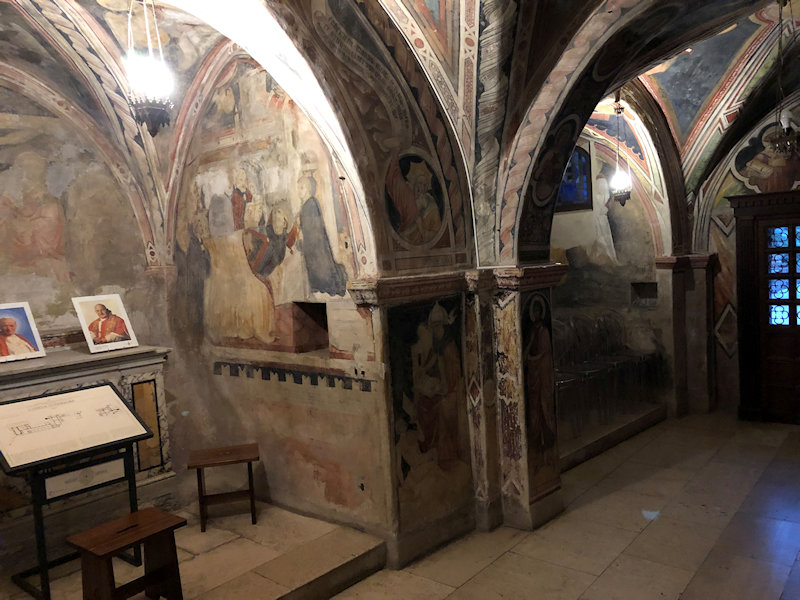

Dormition of the Madonna, probably, or somebody (in which case it's not a 'dormition')
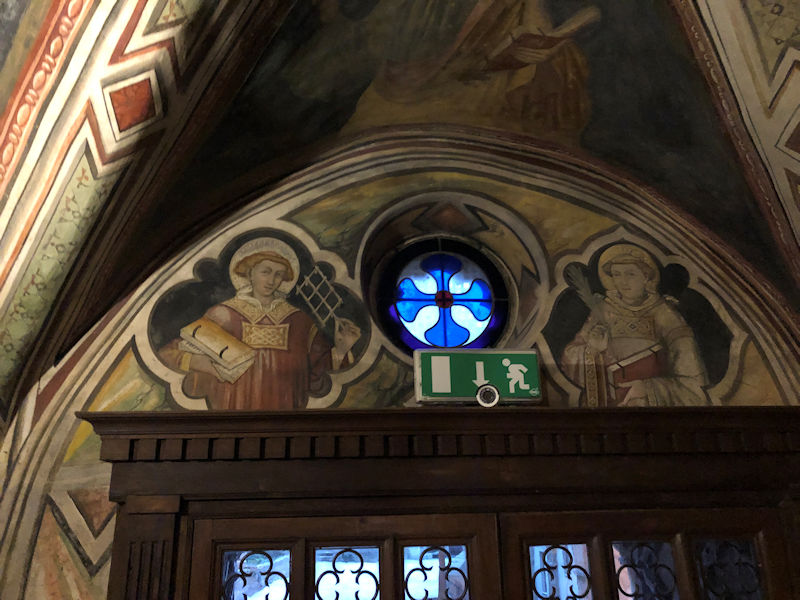
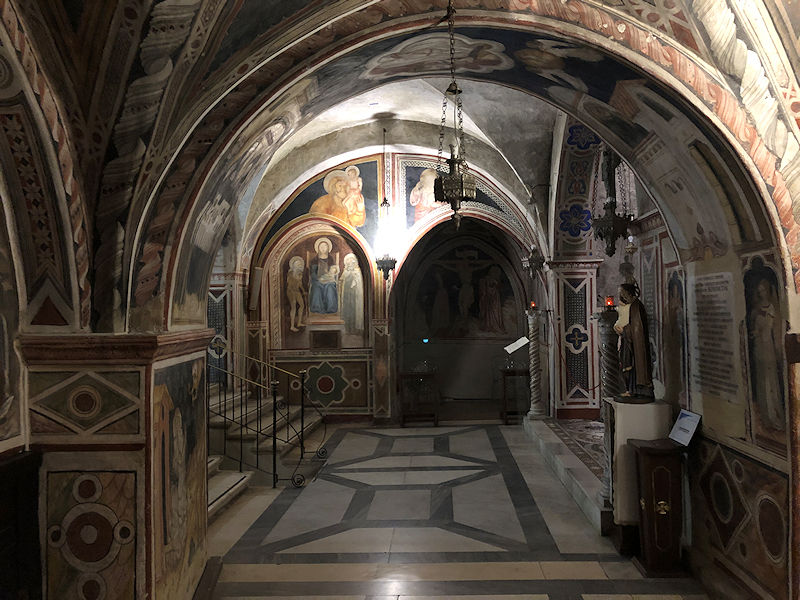
A stairway down, and . . .

. . . another stairway down. The Lower Church is said to be a single nave but on two levels; maybe that's what this is all about.
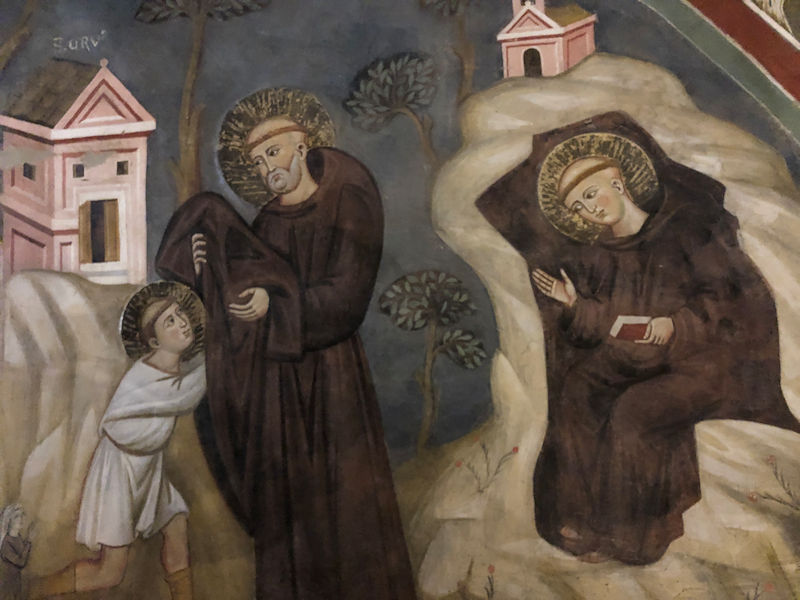
Scenes from the life and miracles of Benedict, presumably, and his friends

That's Benedict and Maurus doing something involving a hook. Fishing, maybe.
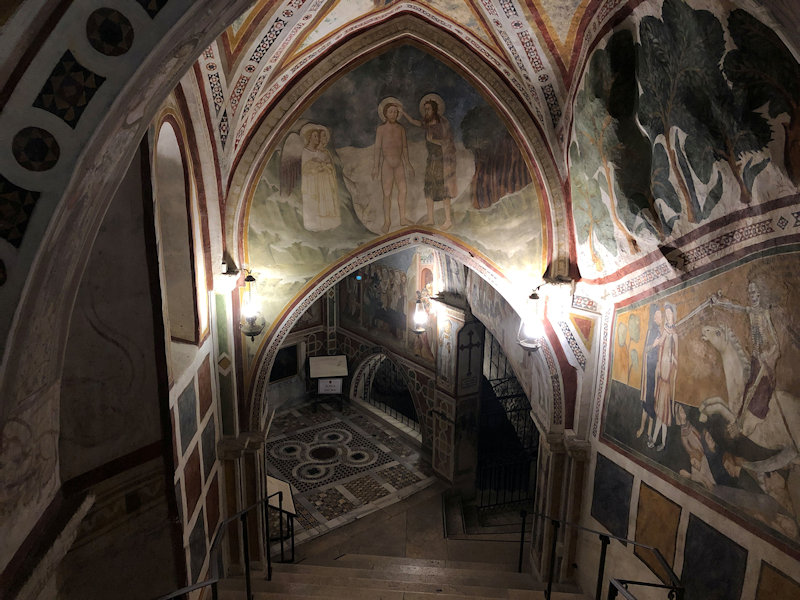
Above the stairway, that's John baptizing Jesus with some obligatory angels looking on. That's a genuine Cosmati floor down below.

To one side on the stairway, the classic representation of the Triumph of Death
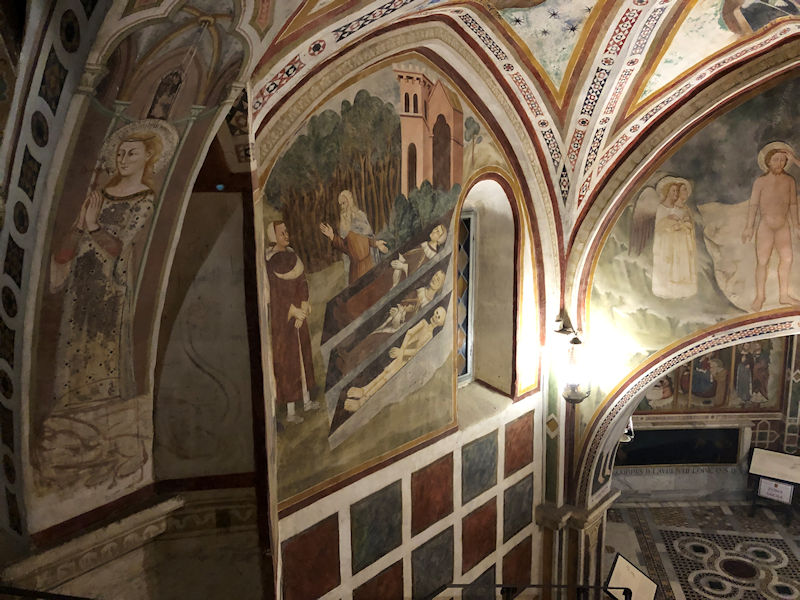
And on the other side, also on the theme of death, this displays the hermit St Macarius showing some young horsemen the different stages of human decomposition in the three coffins (a valuable lesson!).
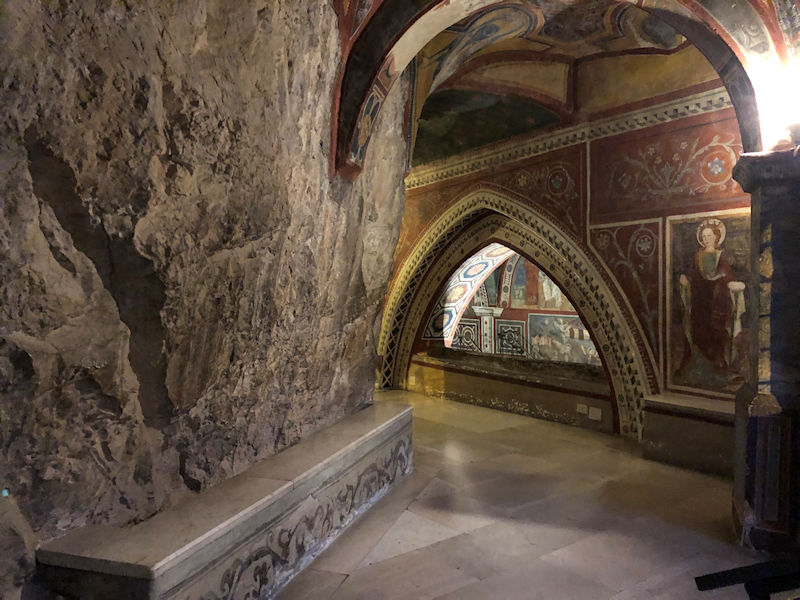
St Gregory's Chapel. Somewhere here in the Capella di San Gregorio is a faint standing portrait of St Francis of Assisi, the only one made of him during his lifetime. 'The absence of the stigmata on the Saint's hands would suggest a probable dating of prior to 1224, the year he received the stigmata.' We missed it entirely.

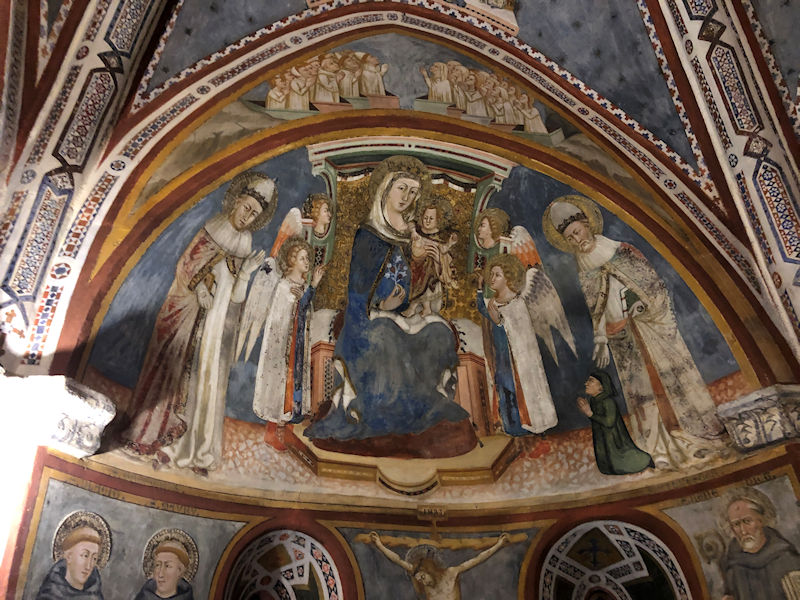
In the Capella della Madonna
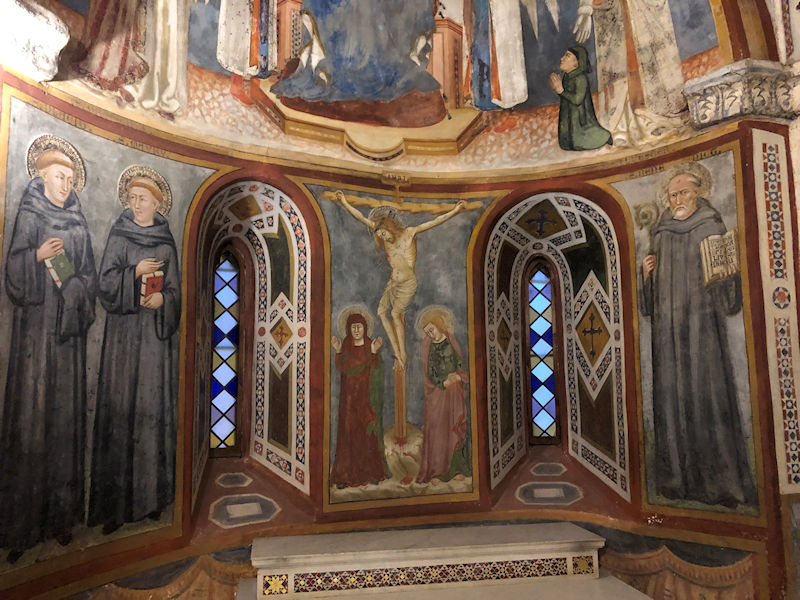
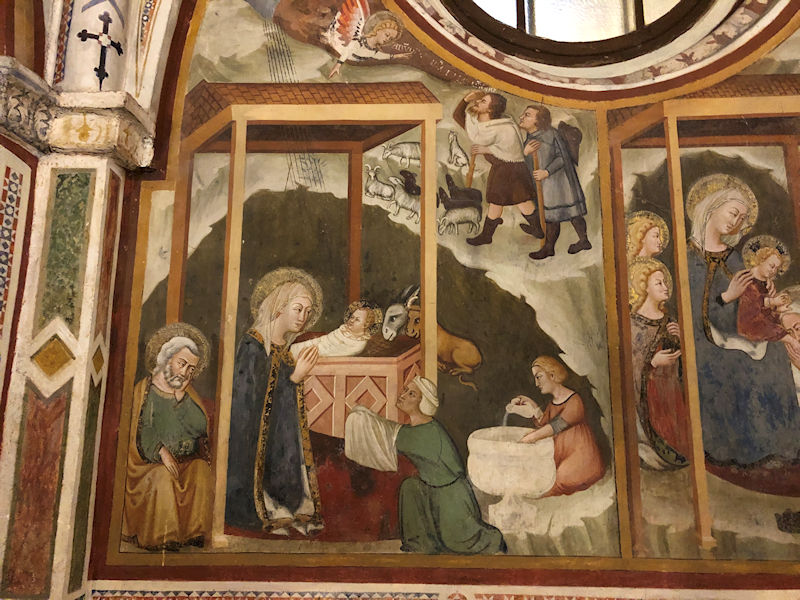
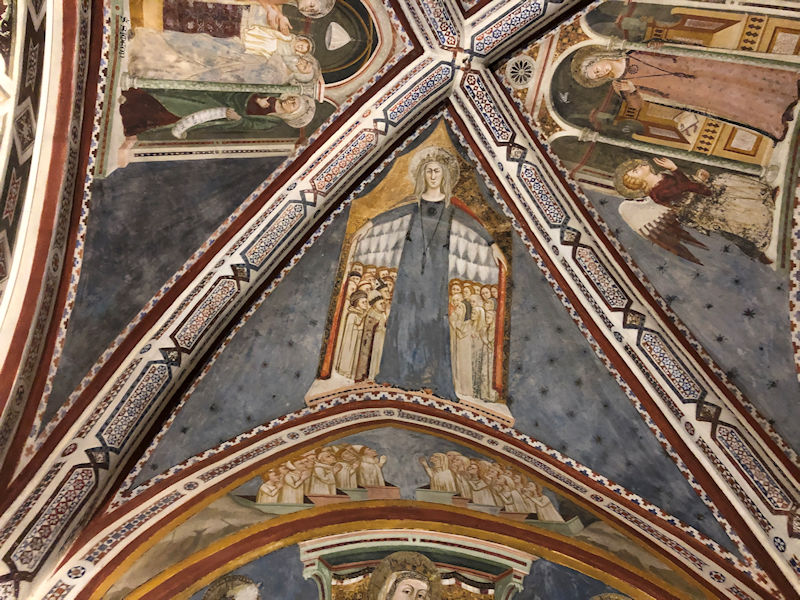
Misericordia . . . the Madonna of Mercy
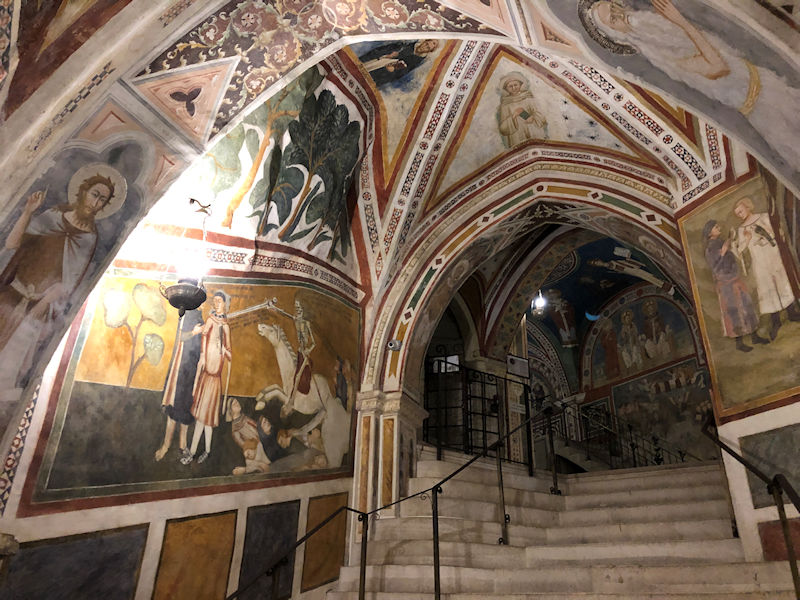
That appears to be the Scala Sancta, the Holy Staircase; normally walked up on the knees, probably, but not this time.
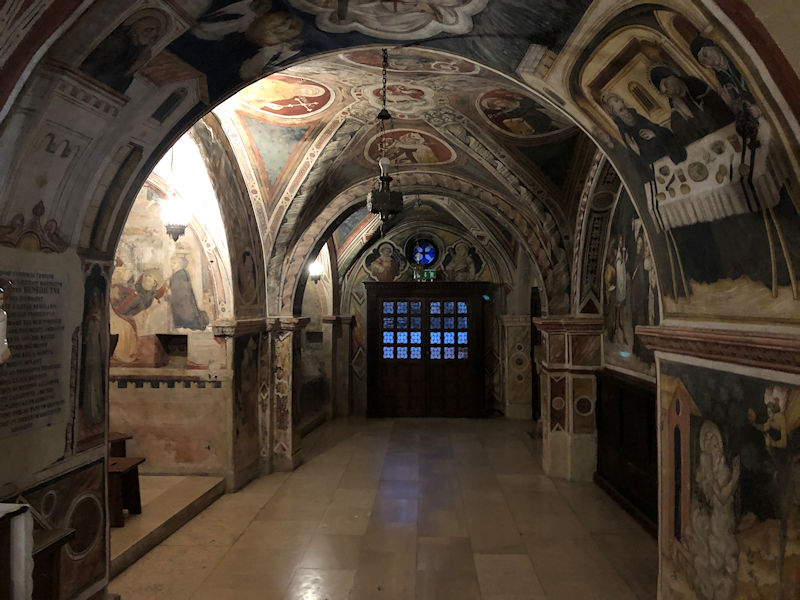

We're back in the Upper Church and heading for the door now
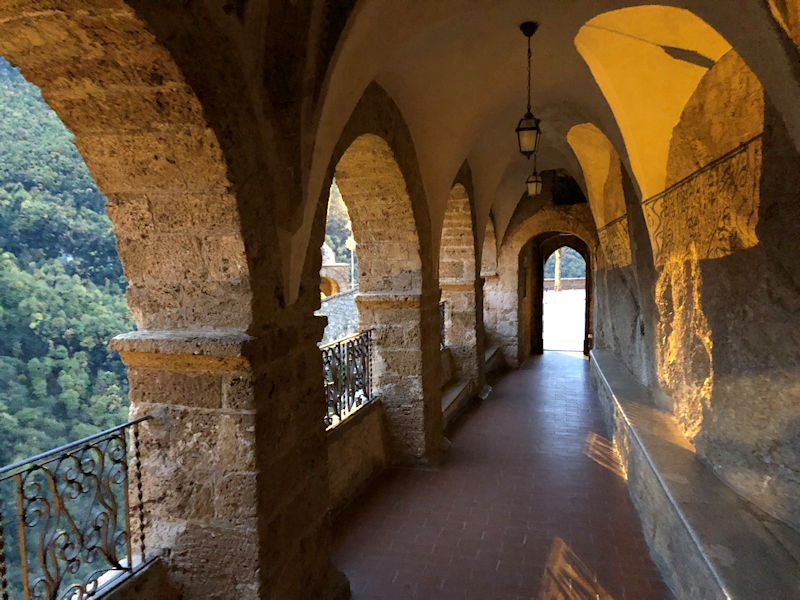
This is marvelous.
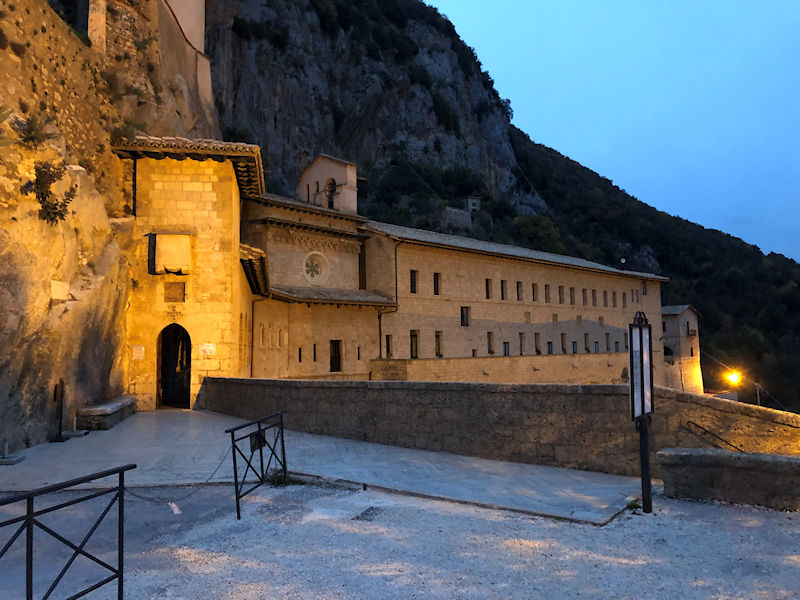
Dusk. It will be time for dinner soon.

And now it is dinnertime indeed. In the Ristorante I Tre Bruschettieri, recommended by our host in the palazzo
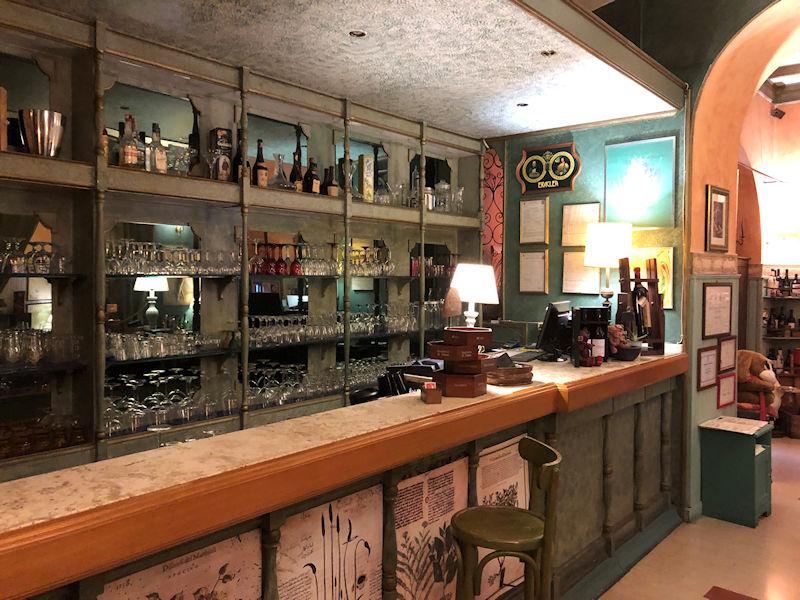
Very good, and with a 10% discount from the palazzo connection
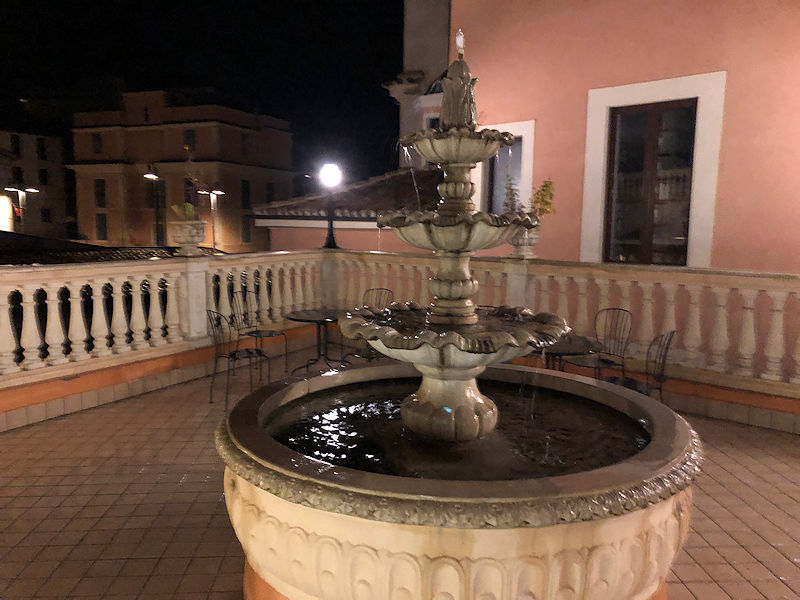
And afterward, a long trudge back up to the Moraschi
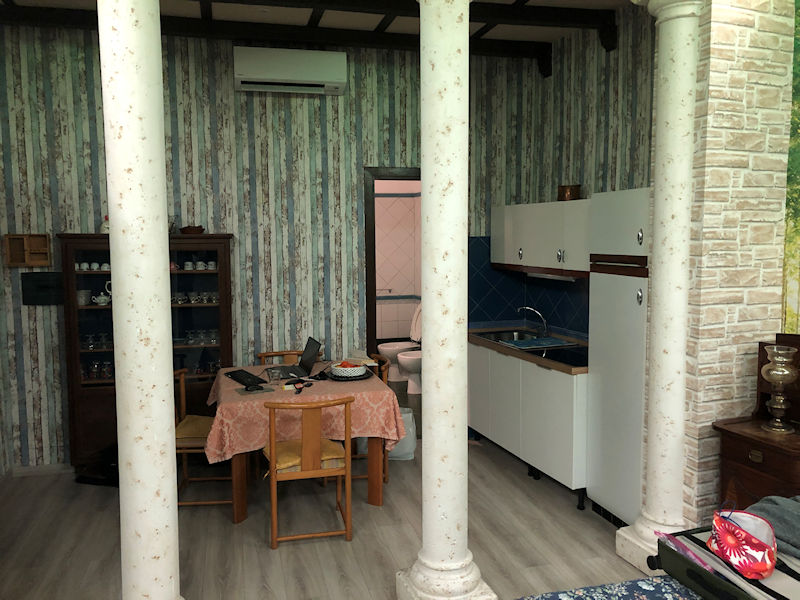
Our room in the Palazzo Moraschi

The atmospheric columns are essentially lawn ornaments, but the room is comfortable.
The next day, bound back towards Rome, we drag the Mitsibushi laboriously out of the tiny parking lot and . . .
. . . wave goodbye to the Rocca dei Borgia on the hill, and to St Benedict's friends and fans.
 Dwight Peck's personal website
Dwight Peck's personal website
































